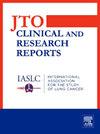老年人参与早期肺癌临床试验,1998年至2020年
IF 3.5
Q2 ONCOLOGY
引用次数: 0
摘要
尽管取得了进展,但肺癌的治疗仍然存在很大的毒性。早期临床试验揭示了新型肺癌治疗方法的安全性和有效性。尽管老年人代表了大多数肺癌患者,但他们在3期试验中的代表性不足,但早期肺癌试验中的年龄差异尚不明确。方法:我们查询了ClinicalTrials.gov网站,以确定自数据库建立以来在成人肺癌患者中进行的早期介入临床试验。我们计算了临床试验人群和美国人群的年龄差异(DA),使用t检验和单侧方差分析来评估与DA相关的试验特征。结果从1998年到2020年,我们纳入了141项临床试验,纳入了7723名参与者。早期肺癌试验参与者平均比美国人群中的肺癌患者年轻7.6岁(平均DA: - 7.6 y, SD 4.2)。在行业资助的临床试验(平均DA为- 8.5对- 6.1,p = 0.001)和那些限制资格的临床试验(平均DA为-8.0对- 6.0,p = 0.040)中,年龄差异被放大了。试验参与者的中位年龄与发生严重不良事件的患者比例之间没有关联。结论在早期肺癌临床试验中,成年患者的代表性仍然不足。随着新型癌症疗法的迅速发展,早期试验设计的重点工作有必要反映现实世界的人群。否则,在治疗安全性和有效性的推广限制可能会增加在未来。本文章由计算机程序翻译,如有差异,请以英文原文为准。
Older Adult Participation in Early-Phase Lung Cancer Clinical Trials, 1998 to 2020
Objectives
Despite advances, lung cancer treatment remains associated with substantial toxicity. Early-phase clinical trials inform the safety and efficacy of novel lung cancer treatments. Although older adults represent most patients with lung cancer, and they are underrepresented in phase 3 trials, age disparity in early-phase lung cancer trials is ill-defined.
Methods
We queried ClinicalTrials.gov to identify early-phase interventional clinical trials conducted in adults with lung cancer since database conception. We calculated the difference in age (DA) between the clinical trial populations and U.S. populations, using t test and one-sided analysis of variance to evaluate trial characteristics associated with DA.
Results
We identified 141 clinical trials enrolling 7723 participants from 1998 to 2020. Early-phase lung cancer trial participants were, on average, 7.6 years younger than patients with lung cancer in the U.S. population (mean DA: −7.6 y, SD 4.2). Age disparities were magnified among clinical trials that were industry-sponsored (mean DA −8.5 versus −6.1, p = 0.001) and those limiting eligibility to Eastern Cooperative Oncology Group performance status less than or equal to 1 (mean DA –8.0 versus −6.0, p = 0.040). There was no association between the median age of trial participants and the proportion of patients with serious adverse events.
Conclusions
Older adults remain underrepresented in early-phase lung cancer clinical trials. With the rapid expansion of novel cancer therapies, focused efforts in the design of early-phase trials are warranted to reflect real-world populations. Otherwise, limitations in the generalizability of treatment safety and efficacy may increase in the future.
求助全文
通过发布文献求助,成功后即可免费获取论文全文。
去求助
来源期刊

JTO Clinical and Research Reports
Medicine-Oncology
CiteScore
4.20
自引率
0.00%
发文量
145
审稿时长
19 weeks
 求助内容:
求助内容: 应助结果提醒方式:
应助结果提醒方式:


